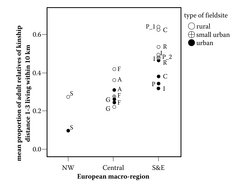Spatial Concentration of Relatives by Macro-Region and Area Type
Over the last few years Patrick Heady has continued to work with issues arising from the findings of the project titled 'KASS - Kinship and Social Security' as set out in Figure 1 below. The existence of differences between European regions is confirmed by many sociological and demographic studies, and extends to other areas of behaviour that border on kinship, including gender relations and fertility levels. There are also differences in religious marriage rules and in attitudes to godparenthood. It is rather remarkable that variations in so many aspects of practical behaviour line up with each other, and that they also correspond to differences in symbolism and in kinship terminology.

The graph is based on data from the collaborative EU-funded research project on kinship and social security in Europe (KASS), collected using an earlier version of the Kinship Network Questionnaire (KNQ1)
Heady has drawn on ethnographic and statistical sources – including but going beyond those provided by the KASS study – to investigate some of these connections. One theme has been the implications of kinship patterns for the functioning of local communities – and the impact of economic change on the relationships concerned. He argues that changing community dynamics help to explain European demographic developments, including the onset of ultra-low fertility (Heady 2017). Another theme has been the attempt to theorise connections between terminology and kinship behaviour in Europe in a way that would be consistent with explanations that have been suggested for kinship in other parts of the world (Heady in press). Reconciling theories of European and non-European kinship may well require changes to the theories on both sides – which takes us back to the ‘big issues’ that we mentioned at the start of this report.
